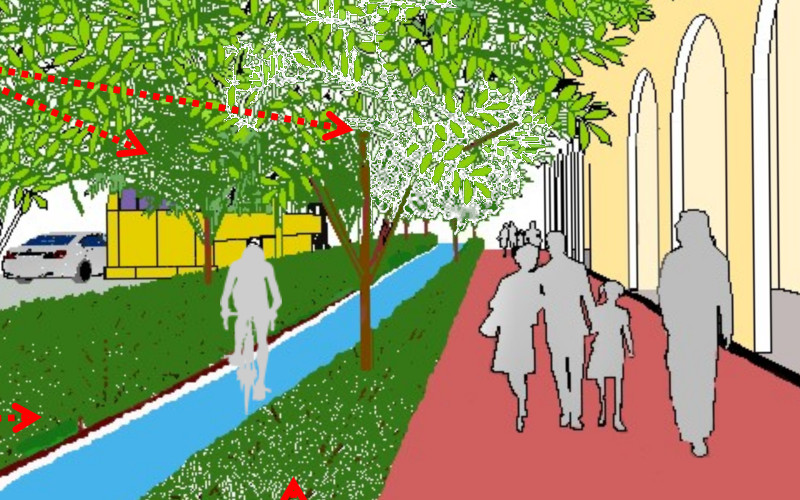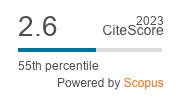Insight into vegetation inclusion along urban roads: A pilot study on the preferences of expatriate roadside users in downtown Doha, Qatar
DOI:
https://doi.org/10.3097/LO.2023.1108Keywords:
Roadside Vegetation, Physical Activity, Users’ Preferences of Benefits of Street Vegetation, Users’ Preferences of Street Vegetation TypesAbstract
Physical Activity (PA) is vital for health and well-being. Automobile-oriented urban development hinders PA in rapidly urbanized cities. In this regard, Complete Streets’ is an emerging design approach to provide equitable services for all road users while promoting PA. Qatar is introducing ‘Complete Streets’ as part of an urban beautification project in which trees are an integral design element. In the capital city of Doha, expatriates constitute a large portion of the resident population; and primary roadside users due to their dependence on public transportation like the Metro rail. Using a quantitative survey, this pilot study conducted in a typical road segment of downtown Doha investigated the preferences of expatriate roadside users for ecosystem services (ES) offered by the street vegetation, the four potential roadside vegetation types, and the associated reasons. The results revealed that the top two preferred ESwere the benefits of street vegetation in the aesthetic enhancement of streets and microclimate regulations. The vegetation type that was perceived to have more greenery was most preferred. The perceived ‘restorative’ benefits of street vegetation mainly influenced the preferences. The findings of this study provide insight into the inclusion of vegetation along roads under the beautification projects in downtown Doha by the Public Works Authority, Ashghal. It is the first study in Qatar that focuses on the preferences of expatriate roadside users for the ES offered by street vegetation and street vegetation types.
References
Akers, A., Barton, J., Cossey, R., Gainsford, P., Griffin, M., Micklewright, D. 2012. Visual color perception in green exercise: positive effects on mood and perceived exertion. Environmental Science & Technology, 46(16), 8661-8666. https://doi.org/10.1021/es301685g DOI: https://doi.org/10.1021/es301685g
Al-Hazzaa, H. M. 2022. Physical Activity Research in the Gulf Cooperation Council Countries: Progress Made but Work Still to Do. Journal of Physical Activity and Health, 19(11), 769-770. https://doi.org/10.1123/jpah.2022-0484 DOI: https://doi.org/10.1123/jpah.2022-0484
An, R., Zhang, S., Ji, M., Guan, C. 2018. Impact of ambient air pollution on physical activity among adults: a systematic review and meta-analysis. Perspect Public Health, 138(2), 111-121. https://doi.org/10.1177/1757913917726567 DOI: https://doi.org/10.1177/1757913917726567
Anderson, G., Searfoss, L., Cox, A., Schilling, E., Seskin, S., Zimmerman, C. 2015. Safer streets, stronger economies: complete streets project outcomes from across the United States. ITE journal, 85(6), 29-36.
Barker, T., Fisher, J. 2019. Ecosystem Health as the Basis for Human Health. In Water and Sanitation-Related Diseases and the Changing Environment (pp. 245-270). https://doi.org/10.1002/9781119415961.ch19 DOI: https://doi.org/10.1002/9781119415961.ch19
Brown, D. K., Barton, J. L., Pretty, J., Gladwell, V. F. 2014. Walks4Work: assessing the role of the natural environment in a workplace physical activity intervention. Scandinavian Journal of Work, Environment & Health, 40(4), 390-399. https://doi.org/10.5271/sjweh.3421 DOI: https://doi.org/10.5271/sjweh.3421
Cohen, J. 1977. CHAPTER 2 - The t Test for Means. In J. Cohen (Ed.), Statistical Power Analysis for the Behavioral Sciences (pp. 19-74). Academic Press. https://doi.org/10.1016/B978-0-12-179060-8.50007-4 DOI: https://doi.org/10.1016/B978-0-12-179060-8.50007-4
Collins, C., Haase, D., Heiland, S., Kabisch, N. 2022. Urban green space interaction and wellbeing – investigating the experience of international students in Berlin during the first COVID-19 lockdown. Urban Forestry & Urban Greening, 70, 127543. https://doi.org/10.1016/j.ufug.2022.127543 DOI: https://doi.org/10.1016/j.ufug.2022.127543
Cui, N., Feng, C. C., Han, R., Guo, L. 2019. Impact of Urbanization on Ecosystem Health: A Case Study in Zhuhai, China. International Journal of Environmental Research and Public Health, 16(23). https://doi.org/10.3390/ijerph16234717 DOI: https://doi.org/10.3390/ijerph16234717
Daniel, T.C., Muhar, A., Arnberger, A., Aznar, O., Boyd, J.W., Chan, K.M.A., Costanza, R., Elmqvist, T., Flint, C.G., Gobster, P.H., Grêt-Regamey, A., Lave, R., Muhar, S., Penker, M., Ribe, R.G., Schauppenlehner, T., Sikor, T., Soloviy, I., Spierenburg, M., Taczanowska, K., Tam, J., Von Der Dunk, A., 2012. Contributions of cultural services to the ecosystem services agenda. Proceedings of the National Academy of Sciences of the United States of America. 109, 8812–8819. https://doi.org/10.1073/pnas.1114773109 DOI: https://doi.org/10.1073/pnas.1114773109
de Vries, S., Have, M., Van Dorsselaer, S., van Wezep, M., Hermans, C. M. L., Graaf, R. 2016. Local availability of green and blue space and prevalence of common mental disorders in the Netherlands. British Journal of Psychiatry Open, 2, 366-372. https://doi.org/10.1192/bjpo.bp.115.002469 DOI: https://doi.org/10.1192/bjpo.bp.115.002469
El-Arifi, S. A. 1986. The Nature of Urbanization in the Gulf Countries. GeoJournal, 13(3), 223-235. DOI: https://doi.org/10.1007/BF00704813
Ennis, C., Peters, C., O’Sullivan, C. 2011. Perceptual Effects of Scene Context and Viewpoint for Virtual Pedestrian Crowds. ACM Transactions on Applied Perception, 8. https://doi.org/10.1145/1870076.1870078 DOI: https://doi.org/10.1145/1870076.1870078
Ersoy Mirici, M. 2022. The Ecosystem Services and Green Infrastructure: A Systematic Review and the Gap of Economic Valuation. Sustainability, 14(1). https://doi.org/10.3390/su14010517 DOI: https://doi.org/10.3390/su14010517
Farahat, A. 2016. Air pollution in the Arabian Peninsula (Saudi Arabia, the United Arab Emirates, Kuwait, Qatar, Bahrain, and Oman): causes, effects, and aerosol categorization. Arabian Journal of Geosciences, 9(3), 196. https://doi.org/10.1007/s12517-015-2203-y DOI: https://doi.org/10.1007/s12517-015-2203-y
Farahat, A. 2022. Chapter 10 - Air quality in the Gulf Cooperation Council (GCC) countries. In R. P. Singh (Ed.), Asian Atmospheric Pollution (pp. 201-226). Elsevier. https://doi.org/10.1016/B978-0-12-816693-2.00013-5 DOI: https://doi.org/10.1016/B978-0-12-816693-2.00013-5
Faul, F., Erdfelder E Fau - Lang, A.-G., Lang Ag Fau - Buchner, A., Buchner, A. 2007). G*Power 3: a flexible statistical power analysis program for the social, behavioral, and biomedical sciences. Behaviour Research Methods, 39(1554-351X (Print)), 175-191. DOI: https://doi.org/10.3758/BF03193146
Fischer, L. K., Gopal, D. 2021. Streetscapes as Surrogate Greenspaces During COVID-19? [Brief Research Report]. Frontiers in Sustainable Cities, 3. DOI: https://doi.org/10.3389/frsc.2021.710920
Fongar, C., Aamodt, G., Randrup, T. B., Solfjeld, I. 2019. Does Perceived Green Space Quality Matter? Linking Norwegian Adult Perspectives on Perceived Quality to Motivation and Frequency of Visits. International journal of environmental research and public health, 16(13), 2327. https://doi.org/10.3390/ijerph16132327 DOI: https://doi.org/10.3390/ijerph16132327
Graça, M., Queirós, C., Farinha-Marques, P., Cunha, M. 2018. Street trees as cultural elements in the city: Understanding how perception affects ecosystem services management in Porto, Portugal. Urban Forestry & Urban Greening, 30, 194-205. https://doi.org/10.1016/j.ufug.2018.02.001 DOI: https://doi.org/10.1016/j.ufug.2018.02.001
Group, The World Bank Group. 2023. Urban population (% of total population) - Middle East and North Africa. The World Bank Group. https://data.worldbank.org/indicator/SP.URB.TOTL.IN.ZS?locations=ZQ [Accessed 12 February 2023]
Hertog, S. 2012. Introduction. In S. Hertog (Ed.), National Employment, Migration and Education in the GCC (pp. 1-6). Gerlach Press. https://doi.org/10.2307/j.ctt1s474nj.3 DOI: https://doi.org/10.2307/j.ctt1s474nj.3
Herzog, T. R., Black, A. M., Fountaine, K. A., Knotts, D. J. 1997. Reflection and Attentional Recovery as Distinctive Benefits of Restorative Environments. Journal of Environmental Psychology, 17(2), 165-170. https://doi.org/10.1006/jevp.1997.0051 DOI: https://doi.org/10.1006/jevp.1997.0051
Kaczynski, A.T., Besenyi, G.M., Stanis, S.A.W., Koohsari, M.J., Oestman, K.B., Bergstrom, R., Potwarka, L.R., Reis, R.S., 2014. Are park proximity and park features related to park use and park-based physical activity among adults? Variations by multiple socio-demographic characteristics. International Journal of Behavioral Nutrition and Physical Activity, 11(1), 146. https://doi.org/10.1186/s12966-014-0146-4 DOI: https://doi.org/10.1186/s12966-014-0146-4
Kaplan, R., Kaplan, S. 1989. The Experience of Nature: A Psychological Perspective. Cambridge University Press.
Klemm, W., Heusinkveld, B. G., Lenzholzer, S., van Hove, B. 2015. Street greenery and its physical and psychological impact on thermal comfort. Landscape and Urban Planning, 138, 87-98. https://doi.org/10.1016/j.landurbplan.2015.02.009 DOI: https://doi.org/10.1016/j.landurbplan.2015.02.009
Kottek, M., Grieser, J., Beck, C., Rudolf, B., Rubel, F. 2006. World Map of the Köppen-Geiger Climate Classification Updated. Meteorologische Zeitschrift, 15, 259-263. https://doi.org/10.1127/0941-2948/2006/0130 DOI: https://doi.org/10.1127/0941-2948/2006/0130
Larcher, F., Pomatto, E., Battisti, L., Gullino, P., Devecchi, M. 2021. Perceptions of Urban Green Areas during the Social Distancing Period for COVID-19 Containment in Italy. Horticulturae, 7(3). https://doi.org/10.3390/horticulturae7030055 DOI: https://doi.org/10.3390/horticulturae7030055
Lindal, P. J., Hartig, T. 2015. Effects of urban street vegetation on judgments of restoration likelihood. Urban Forestry & Urban Greening, 14(2), 200-209. https://doi.org/10.1016/j.ufug.2015.02.001 DOI: https://doi.org/10.1016/j.ufug.2015.02.001
Lusk, A. C., da Silva Filho, D. F., Dobbert, L. 2020. Pedestrian and cyclist preferences for tree locations by sidewalks and cycle tracks and associated benefits: Worldwide implications from a study in Boston, MA. Cities, 106, 102111. https://doi.org/10.1016/j.cities.2018.06.024 DOI: https://doi.org/10.1016/j.cities.2018.06.024
Madureira, H., Nunes, F., Oliveira, J. V., Cormier, L., Madureira, T. 2015. Urban residents’ beliefs concerning green space benefits in four cities in France and Portugal. Urban Forestry & Urban Greening, 14(1), 56-64. https://doi.org/10.1016/j.ufug.2014.11.008 DOI: https://doi.org/10.1016/j.ufug.2014.11.008
MEA, Millenium Ecosystem Assessment. 2005. Ecosystems and Human Well-being: Synthesis.
Mitchell, R. 2013). Is physical activity in natural environments better for mental health than physical activity in other environments? Social Science & Medicine, 91, 130-134. https://doi.org/10.1016/j.socscimed.2012.04.012 DOI: https://doi.org/10.1016/j.socscimed.2012.04.012
Monteiro, R., Ferreira, J. C., Antunes, P. 2020. Green Infrastructure Planning Principles: An Integrated Literature Review. Land, 9(12). https://doi.org/10.3390/land9120525 DOI: https://doi.org/10.3390/land9120525
Niu, J., Xiong, J., Qin, H., Hu, J., Deng, J., Han, G., Yan, J. 2022. Influence of thermal comfort of green spaces on physical activity: Empirical study in an urban park in Chongqing, China. Building and Environment, 219, 109168. https://doi.org/10.1016/j.buildenv.2022.109168 DOI: https://doi.org/10.1016/j.buildenv.2022.109168
PSA, Planning and Statistics Authority. 2020. Residence for Households by Zone 2020. PSA. https://psaqatar.maps.arcgis.com/apps/dashboards/4e2cf1451a8f43c2b258751609752cae [Accessed 12 February 2023]
PSA, Planning and Statistics Authority. 2021. Labor Force Sample Survey. PSA, Qatar. https://www.psa.gov.qa/en/statistics/Statistical%20Releases/Social/LaborForce/2021/Annual_Bulletin_Labour_force_2021_AE.pdf [Accessed 2 February 2023]
QNMP, Qatar National Master Plan. 2019. Qatar Urban Design Compendium (QUDC) (Shaping the Qatari City, Issue. M. o. M. S. o. Qatar). https://www.mm.gov.qa/QatarMasterplan/English/strategicplans.aspx?panel=CompendiumProjects [Accessed 12 February 2023]
Sekaran, U., Bougie, R. 2016. Research Methods For Business: A Skill Building Approach (7 ed.). Wiley.
Shentova, R., de Vries, S., Verboom, J. 2022. Well-Being in the Time of Corona: Associations of Nearby Greenery with Mental Well-Being during COVID-19 in The Netherlands. Sustainability, 14(16), 10256. https://doi.org/10.3390/su141610256 DOI: https://doi.org/10.3390/su141610256
Storgaard, R. L., Hansen, H. S., Aadahl, M., Glümer, C. 2013. Association between neighbourhood green space and sedentary leisure time in a Danish population. Scandinavian Journal of Public Health, 41(8), 846-852. https://www.jstor.org/stable/45151089 DOI: https://doi.org/10.1177/1403494813499459
Sugiyama, T., Leslie, E., Giles-Corti, B., Owen, N. 2008. Associations of neighbourhood greenness with physical and mental health: do walking, social coherence and local social interaction explain the relationships? Journal of Epidemiology and Community Health, 62(5), e9. https://doi.org/10.1136/jech.2007.064287 DOI: https://doi.org/10.1136/jech.2007.064287
Uebel, K., Rhodes, J. R., Wilson, K., Dean, A. J. 2022. Urban park soundscapes: Spatial and social factors influencing bird and traffic sound experiences [https://doi.org/10.1002/pan3.10409]. People and Nature, 4(6), 1616-1628. https://doi.org/10.1002/pan3.10409 DOI: https://doi.org/10.1002/pan3.10409
Ulrich, R., Simons, R., Losito, B., Fiorito, E., Miles, M., Zelson, M. 1991. Stress Recovery During Exposure to Natural and Urban Environments. Journal of Environmental Psychology. 11: 201-230. Journal of Environmental Psychology, 11, 201- 230. https://doi.org/10.1016/S0272-4944(05)80184-7 DOI: https://doi.org/10.1016/S0272-4944(05)80184-7
Ulrich, R. S. 1984. View Through a Window May Influence Recovery from Surgery. Science, 224(4647), 420-421. https://doi.org/10.1126/science.6143402 DOI: https://doi.org/10.1126/science.6143402
UN, United Nations. 2019. World Urbanization Prospects - The 2018 Revision.
WHO, World Health Organization. 2017. Urban Green Space Interventions and Health: A review of impacts and effectiveness.
WHO, World Health Organization. 2018a. Global Action Plan On Physical Activity 2018-2030. More Active People for Healthier World. In. Geneva.
WHO, World Health Organization. 2018b. Noncommunicable diseases country profiles 2018. World Health Organization.
WHO, World Health Organization. 2019. Insufficient Physical Activity: Prevalence of insufficient physical activity in adults, ages 18+ (age standardized estimates), 2016. https://gamapserver.who.int/gho/interactivecharts/ncd/risk_factors/physical_inactivity/atlas.html?indicator=i1&date=Male [Accessed 12 February 2023]

Downloads
Published
How to Cite
Issue
Section
License
Copyright (c) 2023 Soujanya Mogra, Mohd Faris Khamidi, Fodil Fadli

This work is licensed under a Creative Commons Attribution 4.0 International License.










